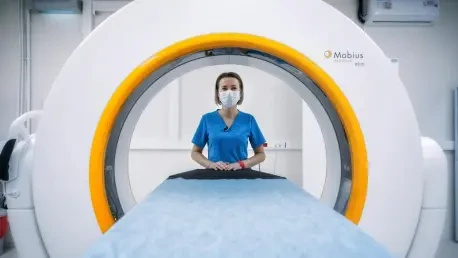In Westbury, New York, an MRI machine claimed the life of Keith McAllister, a 61-year-old man, prompting a serious reevaluation of the safety protocols governing such powerful diagnostic tools. On July 16, an ordinary medical appointment took a tragic turn when McAllister, adorned with a 20-pound metallic weight-training chain, entered the MRI room. The machine’s colossal magnetic force, designed to capture detailed images of the body’s interior, instead dragged him forcefully toward its core. This incident unfolded despite attempts to prevent disaster; his wife and an MRI technician struggled for nearly an hour to free him. The delay was fatal, resulting in multiple heart attacks. Following the incident, McAllister was taken to a hospital, where he succumbed to his injuries the following day. This incident underscores the essential nature of strict adherence to established safety measures, particularly guidelines that prohibit bringing metallic objects near MRI equipment. While McAllister’s story is personal, it conveys a broader message on the importance of comprehensive safety protocols to prevent similar tragedies in the future.
Examining Safety Protocols and Their Importance
MRI procedures involve substantial risks; understanding them and mitigating potential dangers is essential for medical personnel. The MRI’s magnetic field is incredibly strong and is on without interruption, requiring that all metallic items be strictly prohibited within the vicinity. Lapses in following these protocols can have devastating consequences, as the absence of thorough checks results in the machine’s magnetic forces causing unintended interactions with metals. This was vividly illustrated in the McAllister incident, where a seemingly harmless piece of jewelry turned lethal due to its proximity to the MRI’s magnetic field. Although the protocol mandates removing such items, overlooking this step indicates a significant vulnerability in ensuring patient and staff safety. Emphasizing the importance of stringent procedural checks and balances is paramount. Instituting rigorous training programs to identify and eliminate human error could drastically reduce the likelihood of similar scenarios occurring in the future. Ultimately, patient safety is contingent upon unwavering adherence to these protocols, without exception or oversight. Such diligence ensures the MRI serves as a safe and effective diagnostic tool rather than a potential hazard.
Strengthening Awareness and Enforcement
Increasing awareness about MRI safety extends beyond the healthcare environment into public consciousness. Informing both patients and medical staff about potential hazards associated with MRI machines must become a priority. It involves educating all parties on the critical guidelines that safeguard against accidents, ensuring everyone entering the MRI room clearly understands the prohibitions against metallic items. Enhancing educational outreach, perhaps through mandatory orientation sessions for patients prior to procedures, could foster better compliance and awareness. Such initiatives necessitate a collaborative effort not only between healthcare professionals but also with device manufacturers to continually update and refine safety protocols. Stringent enforcement measures, including routine audits and inspections, can reinforce the importance of adhering to these standards. Cultivating an environment of safety vigilance will instill a culture where the precautions are not merely procedural but integral to the practice. As the use of MRI technology only continues to expand, taking proactive steps in fortifying safety measures becomes integral to safeguarding lives and advancing medical practices.
Impact on the McAllister Family and Community
Beyond its technical implications, the incident profoundly affected those left to mourn Keith McAllister’s unexpected passing. Family and friends remember him as a cherished husband, father, and friend, whose life was cut short by an avoidable tragedy. In their grieving, the family has navigated both emotional and financial hardships, initiating a GoFundMe campaign that raised nearly $7,000 by July 21 to help shoulder funeral costs. The wider Long Island community expressed their shock and solidarity, highlighting a rallying effort that underscores the deep impact such accidents have beyond the medical field. This tragedy emphasizes the human dimension often overshadowed by technicalities, reminding that behind every statistic is a grieving family left grappling with loss. The ongoing police investigations, alongside reviews from the Nassau County Medical Examiner, have kept attention focused on accountability and potential procedural inadequacies. The McAllisters’ ordeal underscores the critical need for robust safety protocols and their unwavering enforcement, ensuring others need not endure similar heartaches.
Moving Forward with Lessons Learned
In Westbury, New York, a tragic incident involving an MRI machine claimed the life of Keith McAllister, a 61-year-old man. On July 16th, what started as a routine medical appointment took a catastrophic turn when McAllister, wearing a 20-pound metal weight-training chain, entered the MRI room. The machine, which uses a powerful magnetic field to create detailed images of the body, instead pulled McAllister toward its core with immense force. Despite desperate efforts by his wife and an MRI technician, who tried for nearly an hour to save him, the delay proved fatal. He suffered multiple heart attacks and was rushed to the hospital, where he died the next day. This incident has sparked a critical review of safety protocols for MRI machines. It highlights the urgency of strictly adhering to safety measures, particularly the prohibition against bringing metal objects near MRI equipment. While McAllister’s story is deeply personal, it sends a broader warning about the need for strict safety protocols to avoid similar tragedies.









